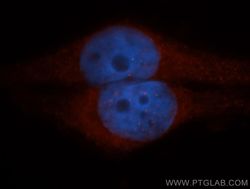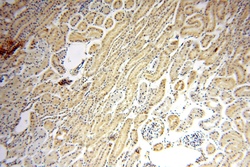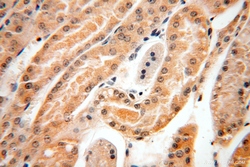Antibody data
- Antibody Data
- Antigen structure
- References [8]
- Comments [0]
- Validations
- Western blot [1]
- Immunocytochemistry [1]
- Immunohistochemistry [2]
Submit
Validation data
Reference
Comment
Report error
- Product number
- 14545-1-AP - Provider product page

- Provider
- Proteintech Group
- Proper citation
- Proteintech Cat#14545-1-AP, RRID:AB_2081809
- Product name
- CLIC1 antibody
- Antibody type
- Polyclonal
- Description
- CLIC1 antibody (Cat. #14545-1-AP) is a rabbit polyclonal antibody that shows reactivity with human, mouse, rat and has been validated for the following applications: IF, IHC, IP, WB,ELISA.
- Reactivity
- Human, Mouse, Rat
- Host
- Rabbit
- Conjugate
- Unconjugated
- Isotype
- IgG
- Vial size
- 20ul, 150ul
Submitted references Extracellular Acidification Augments NLRP3-Mediated Inflammasome Signaling in Macrophages.
Chloride intracellular channel 1 promotes esophageal squamous cell carcinoma proliferation via mTOR signalling.
Attenuation of ROS/Chloride Efflux-Mediated NLRP3 Inflammasome Activation Contributes to Alleviation of Diabetic Cardiomyopathy in Rats after Sleeve Gastrectomy.
Chloride Intracellular Channel 1 is a Potential Biomarker for Breast Cancer.
Label-free LC-MS/MS proteomics analyses reveal CLIC1 as a predictive biomarker for bladder cancer staging and prognosis.
Chloride Intracellular Channel 1 Expression Is Associated With Poor Prognosis of Lung Adenocarcinoma.
CLIC1 Drives Angiogenesis in Hepatocellular Carcinoma by Modulating VEGFA.
CLIC1 Inhibition Protects Against Cellular Senescence and Endothelial Dysfunction Via the Nrf2/HO-1 Pathway.
Chae BJ, Lee KS, Hwang I, Yu JW
Immune network 2023 Jun;23(3):e23
Immune network 2023 Jun;23(3):e23
Chloride intracellular channel 1 promotes esophageal squamous cell carcinoma proliferation via mTOR signalling.
Geng H, Feng C, Sun Z, Fan X, Xie Y, Gu J, Fan L, Liu G, Li C, Thorne RF, Zhang XD, Li X, Liu X
Translational oncology 2023 Jan;27:101560
Translational oncology 2023 Jan;27:101560
Attenuation of ROS/Chloride Efflux-Mediated NLRP3 Inflammasome Activation Contributes to Alleviation of Diabetic Cardiomyopathy in Rats after Sleeve Gastrectomy.
Li S, Dong S, Shi B, Xu Q, Li L, Wang S, Zhang W, Zhong M, Zhu J, Cheng Y, Zhang G, Hu S
Oxidative medicine and cellular longevity 2022;2022:4608914
Oxidative medicine and cellular longevity 2022;2022:4608914
Chloride Intracellular Channel 1 is a Potential Biomarker for Breast Cancer.
Xia J, Wang Q, Ju F, Luo X, Wang F, Zhou Y, Huang H, Wang H, Bao X
Breast cancer (Dove Medical Press) 2022;14:247-258
Breast cancer (Dove Medical Press) 2022;14:247-258
Label-free LC-MS/MS proteomics analyses reveal CLIC1 as a predictive biomarker for bladder cancer staging and prognosis.
Wang W, Huang G, Lin H, Ren L, Fu L, Mao X
Frontiers in oncology 2022;12:1102392
Frontiers in oncology 2022;12:1102392
Chloride Intracellular Channel 1 Expression Is Associated With Poor Prognosis of Lung Adenocarcinoma.
Yasuda Y, Nagano T, Jimbo N, Kiriu T, Suraya R, Hazama D, Yamamoto M, Maniwa Y, Nishimura Y, Kobayashi K
Anticancer research 2022 Jan;42(1):271-277
Anticancer research 2022 Jan;42(1):271-277
CLIC1 Drives Angiogenesis in Hepatocellular Carcinoma by Modulating VEGFA.
Wei X, Pan B, Yang M, Shu W, Khan AR, Su R, Lin H, Xu X
Technology in cancer research & treatment 2022 Jan-Dec;21:15330338221106820
Technology in cancer research & treatment 2022 Jan-Dec;21:15330338221106820
CLIC1 Inhibition Protects Against Cellular Senescence and Endothelial Dysfunction Via the Nrf2/HO-1 Pathway.
Lu D, Le Y, Ding J, Dou X, Mao W, Zhu J
Cell biochemistry and biophysics 2021 Jun;79(2):239-252
Cell biochemistry and biophysics 2021 Jun;79(2):239-252
No comments: Submit comment
Supportive validation
- Submitted by
- Proteintech Group (provider)
- Main image

- Experimental details
- HeLa cells were subjected to SDS PAGE followed by western blot with 14545-1-AP( CLIC1 Antibody) at dilution of 1:200
- Sample type
- cell line
Supportive validation
- Submitted by
- Proteintech Group (provider)
- Main image

- Experimental details
- Immunofluorescent analysis of HepG2 cells, using CLIC1 antibody 14545-1-AP at 1:50 dilution and Rhodamine-labeled goat anti-rabbit IgG (red). Blue pseudocolor = DAPI (fluorescent DNA dye).
- Sample type
- cell line
Supportive validation
- Submitted by
- Proteintech Group (provider)
- Main image

- Experimental details
- Immunohistochemical of paraffin-embedded human kidney using 14545-1-AP(CLIC1 antibody) at dilution of 1:50 (under 10x lens)
- Sample type
- tissue
- Submitted by
- Proteintech Group (provider)
- Main image

- Experimental details
- Immunohistochemical of paraffin-embedded human kidney using 14545-1-AP(CLIC1 antibody) at dilution of 1:50 (under 40x lens)
- Sample type
- tissue
 Explore
Explore Validate
Validate Learn
Learn Western blot
Western blot ELISA
ELISA